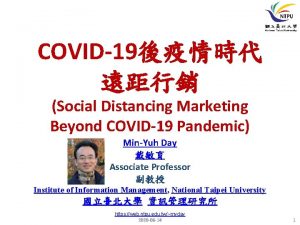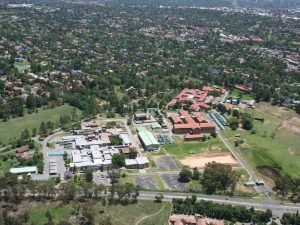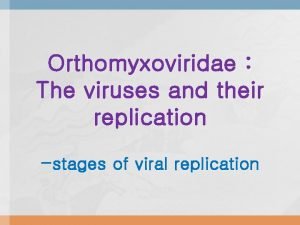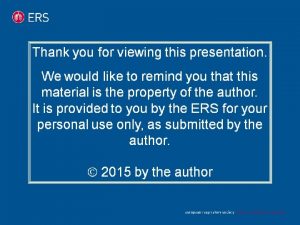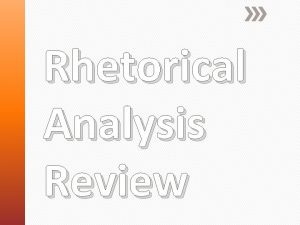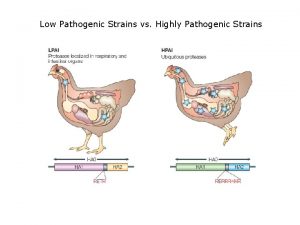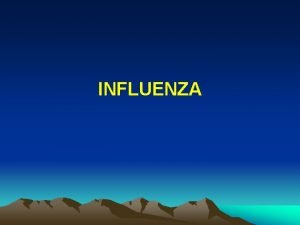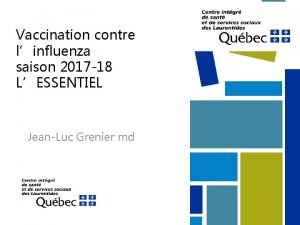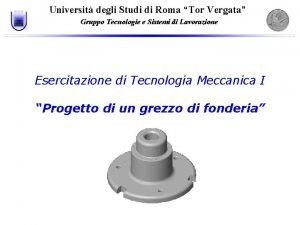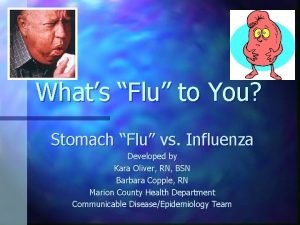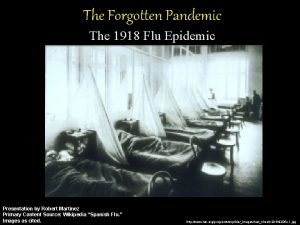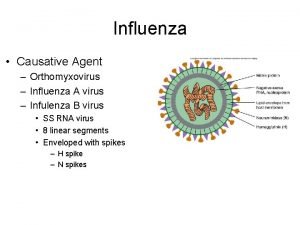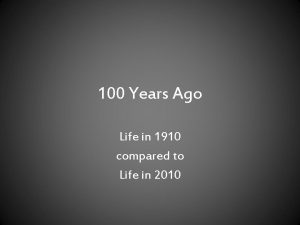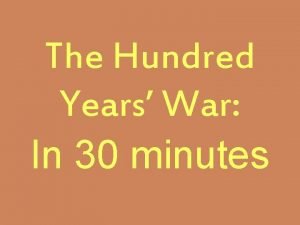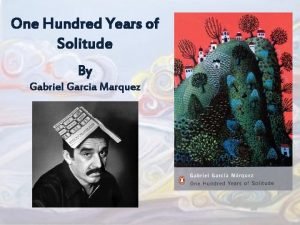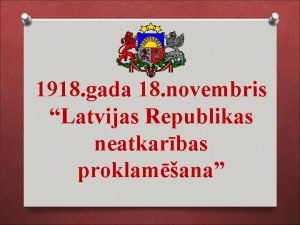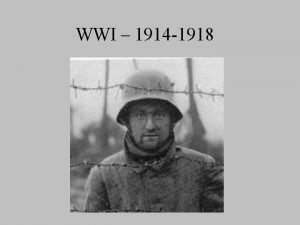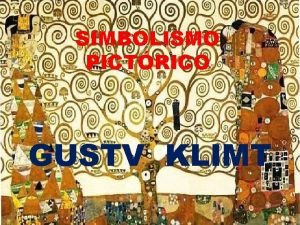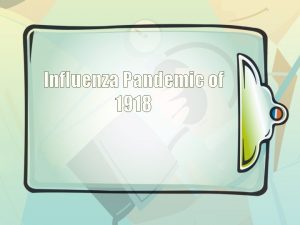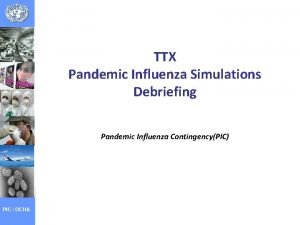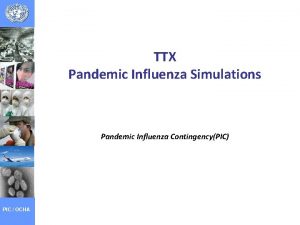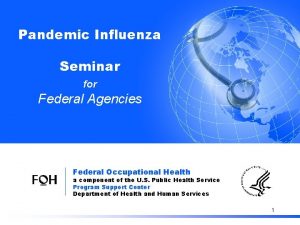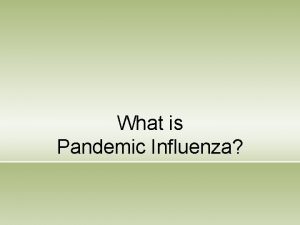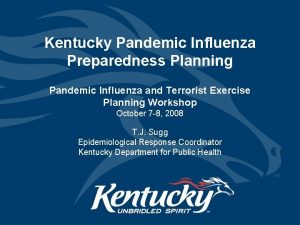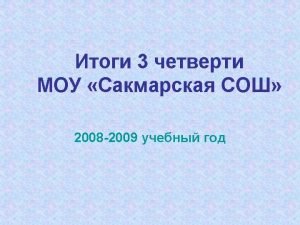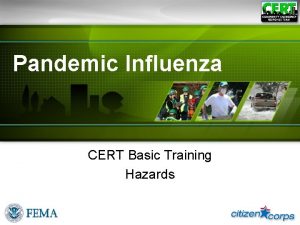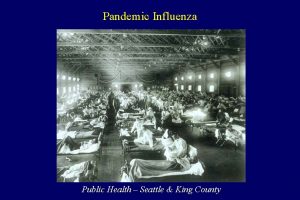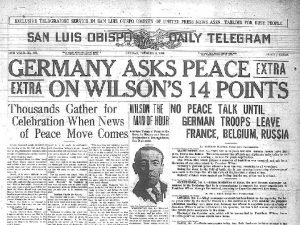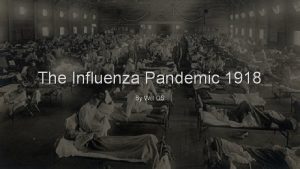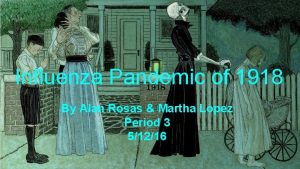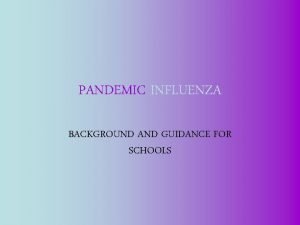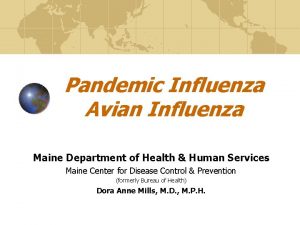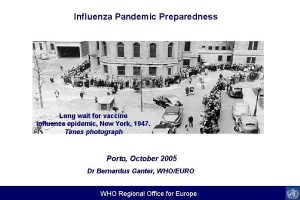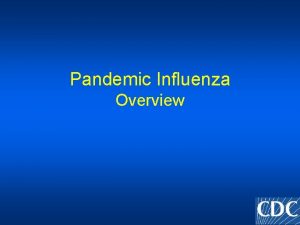100 YEARS AFTER THE 1918 INFLUENZA PANDEMIC KNOWN




































- Slides: 36



100 YEARS AFTER THE 1918 INFLUENZA PANDEMIC KNOWN AS "SPANISH FLU" RAVAGED THE GLOBE, WHAT HAVE WE LEARNED?

QTHERE WAS NOTHING “SPANISH” ABOUT THE INFLUENZA EPIDEMIC OF 1918, WHICH BEGAN DURING WORLD WAR I AND AFFECTED COUNTRIES AROUND THE GLOBE. THE COST IN HUMAN LIFE ECLIPSED THAT OF WORLD WAR I: MORE AMERICAN TROOPS, FOR INSTANCE, DIED FROM FLU THAN THEY DID IN THE BATTLE FIELD.

A MODERN DISEASE q. Although influenza has been with humankind for millenia, the virulence and global spread is in many respects a function of modern times. Urbanization, mass migration, global transport and trade, and overcrowding accelerate the spread of pandemics, which ignore national borders, social class, economic status, and even age. The 1918 Pandemic, for instance, was unusually fatal in the 20 -to-40 age group. Like many other diseases, influenza pandemics impact the poor the hardest. At the same time, they disrupt the economy and basic social functions like school and other mass gatherings.


ETIOLOGIC • Influenza viruses are members of the Orthomyxoviridae family, of which influenza A, B, and C viruses constitute three separate genera • The designation of influenza viruses as type A, B, or C is based on antigenic characteristics of the nucleoprotein (NP) and matrix (M) protein antigens • Individual strains are designated according to the site of origin, isolate number, year of isolation, and subtype—for example, influenza A/California/07/2009 (H 1 N 1)

Influenza Structure 8 RNA segments hegazi 8@hotmail. com Hemagglutinin Neuraminidase 8

• Influenza A has 18 distinct H subtypes and 11 distinct N subtypes, of which only H 1, H 2, H 3, N 1, and N 2 have been associated with epidemics of disease in humans

How Influenza Changes Its Surface Proteins hegazi 8@hotmail. com Small Changes = Drift 10

ﺍﺯ پﺮﻧﺪﻩ ﺑﻪ ﺍﻧﺴﺎﻥ Domestic birds 11 Migratory water birds Hong Kong, SAR • China 1997, H 5 N 1 Hong Kong, SAR • China 1999, H 9 N 2 The Netherlands • 2003, H 7 N 7 Hong Kong, SAR • China 2003, H 5 N 1 hega zi 8@ hot Source: WHO/WPRO mail. com

ﻧﻮﺗﺮﻛﻴﺒﻲ ﺩﺭ ﺍﻧﺴﺎﻥ 12 Migratory water birds hega zi 8@ hot Source: WHO/WPRO mail. com

ﻧﻮﺗﺮﻛﻴﺒﻲ ﺩﺭ ﺧﻮﻙ 13 Migratory water birds hega zi 8@ hot Source: WHO/WPRO mail. com

ﺟﻬﺶ ) ﻣﻮﺗﺎﺳﻴﻮﻥ ( ﺩﺭ ﺍﻧﺴﺎﻥ 14 Migratory water birds hega zi 8@ hot Source: WHO/WPRO mail. com

Worldwide distribution Outbreaks usually occur suddenly Flu spreads through communities resulting in an epidemic. Cases tend to peak after about 3 weeks and begin to subside after another 3 -4 weeks Peak season is November through March

Have been several great influenza pandemics: � 1918 -19 “Spanish” flu l Caused 20 -40 million deaths worldwide l A large proportion of these deaths was in healthy adults 20 to 40 years of age � 1957 “Asian” flu � 1968 “Hong Kong” flu � 1977 H 1 N 1 influenza A virus subtype, “Russian” flu

TRANSMISSION Major transmission route is through airborne large respiratory droplets with particles larger than 5 microns (μ) in diameter that are expelled from the respiratory tract of an infected person when they cough or sneeze Direct contact with fomites (inanimate objects) contaminated with infected droplets or secretions and then touching ones nose or mouth Transmission from infected birds, poultry or pigs (less common)

INCUBATION PERIOD 1 to 21 days with average of 2 days Adults are infectious from day before symptoms begin through about 5 days after onset; children can be infectious for 10 or more days after onset and those who are immunosuppressed can shed virus for weeks or even months.


Q NATIONAL INFLUENZA CENTRES (NICS) AND OTHER NATIONAL INFLUENZA LABORATORIES 104 COUNTRIES, AREAS OR TERRITORIES REPORTED DATA TO FLUNET FOR THE TIME PERIOD FROM 15 OCTOBER 2018 TO 28 OCTOBER 2018. THE WHO GISRS LABORATORIES TESTED MORE THAN 84313 SPECIMENS DURING THAT TIME PERIOD. 2145 WERE POSITIVE FOR FROM INFLUENZA VIRUSES

qinfluenza A 86% q influenza B 14% q Of the sub-typed influenza A viruses, 64. 5% were influenza A(H 1 N 1)pdm 09 and 35. 5% were influenza A(H 3 N 2). q. Of the characterized B viruses, 52. 4% belonged to the B -Yamagata lineage and 47. 6% to the B-Victoria lineage






ﺗﻮﺻیﻪ ﻫﺎی ﺳﺎﺯﻣﺎﻥ ﺟﻬﺎﻧی ﺑﻬﺪﺍﺷﺖ 98 ﺑﺮﺍی ﻭﺍکﺴﻦ آﻨﻔﻠﻮﺍﻧﺰﺍ ﺑﺮﺍی ﻓﺼﻞ 1397 q It is recommended that quadrivalent vaccines for use in the 2018 -2019 northern hemisphere influenza season contain the following: - an A/Michigan/45/2015 (H 1 N 1)pdm 09 -like virus; - an A/Singapore/INFIMH-16 -0019/2016 (H 3 N 2)-like virus; - a B/Colorado/06/2017 -like virus (B/Victoria/2/87 lineage); and - a B/Phuket/3073/2013 -like virus (B/Yamagata/16/88 lineage). q It is recommended that the influenza B virus component of trivalent vaccines for use in the 2018 -2019 northern hemisphere influenza season be a B/Colorado/06/2017 -like virus of the B/Victoria/2/87 -lineage.









 100 100 100 100 100
100 100 100 100 100 1453-1337
1453-1337 John 14 1-3
John 14 1-3 After me after me after me
After me after me after me Mathalicious pandemic answer key
Mathalicious pandemic answer key Covid 19 pandemic summary
Covid 19 pandemic summary Global pandemic preparedness
Global pandemic preparedness Interpandemic
Interpandemic Pandemic tabletop exercise template
Pandemic tabletop exercise template 300 solar years to lunar years
300 solar years to lunar years Four score and seven years ago
Four score and seven years ago Sheep years to human years
Sheep years to human years Influenza virus replication
Influenza virus replication Influenza
Influenza The great influenza rhetorical analysis
The great influenza rhetorical analysis Fibertel
Fibertel Low pathogenic avian influenza
Low pathogenic avian influenza Influenza
Influenza Influenza vaccine dosage chart 2019-2020
Influenza vaccine dosage chart 2019-2020 Metodo dei cerchi di heuvers
Metodo dei cerchi di heuvers Stomach flu vs influenza
Stomach flu vs influenza Influenza ww1
Influenza ww1 Influenza causative agent
Influenza causative agent Is influenza a airborne disease
Is influenza a airborne disease Family life 100 years ago
Family life 100 years ago Consequences of the 100 years war
Consequences of the 100 years war World in 100 years
World in 100 years Justice definiton
Justice definiton Jose arcadio segundo
Jose arcadio segundo Foreshadowing in after twenty years
Foreshadowing in after twenty years After twenty years summary
After twenty years summary Hen duo xie
Hen duo xie 11 listopada 1918 piosenka tekst
11 listopada 1918 piosenka tekst 18 novembris 1918
18 novembris 1918 Map of europe 1914
Map of europe 1914 Hammer v. dagenhart
Hammer v. dagenhart Gustv
Gustv





